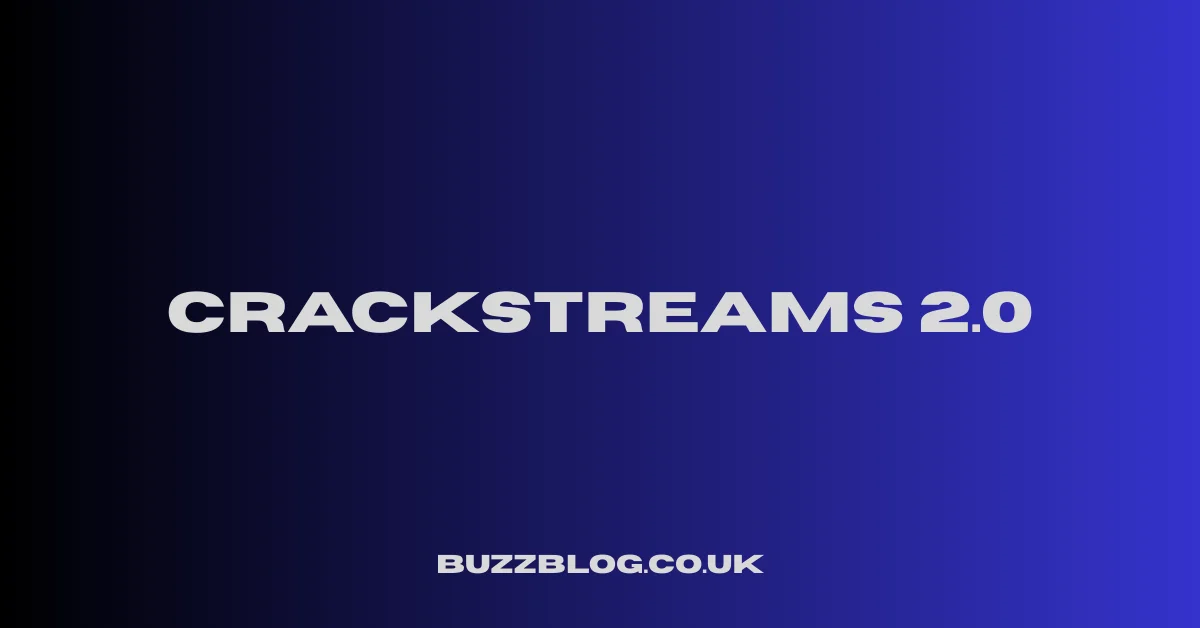Introduction
TL;DR: What this article covers
Crackstreams 2.0 is shorthand for a new wave of free sports streaming sites and mirror networks that try to deliver live games without a subscription. This article explains what these platforms are, why people use them, the legal and security risks involved, how rights-holders are fighting back, and—crucially—what safer, legal alternatives exist. Along the way you’ll get practical, non-actionable advice about protecting your device and your data.
What is (and isn’t) “Crackstreams 2.0”?
Origins and the first CrackStreams wave
If you’ve followed internet sports culture for a while, you’ve probably bumped into CrackStreams, Streameast, Buffstreams and similar names. These sites aggregated links to live streams of sporting events (NBA, NFL, soccer, MMA, you name it) and surfaced them in a simple interface. For users, the pitch was irresistible: pay nothing, watch live. For rights-holders, it was a revenue and control nightmare.
Where “2.0” comes from — a rebrand or just more mirrors?
“Crackstreams 2.0” is less a single site and more a pattern: after crackdowns, operators shift domains, spin up mirrors, or hand code new front-ends promising a better, faster experience — hence the “2.0” label users slap on the newest incarnations. What changes is cosmetic (UI, fewer popups) and technical (different CDN setups, more automated link harvesting), but the basic model of redistributing live broadcasts without authorization stays the same. Recent anti-piracy operations have targeted these networks specifically, showing that the game is evolving on both sides. PR Newswire
How free sports streaming actually works (high-level)
Aggregation, mirrors, and embed engines
Most free sports streaming sites don’t generate original video — they aggregate. They scrape or accept user-submitted links to broadcasts hosted on other servers, embed those streams, and present them in one place. When takedowns happen, operators quickly swap to mirror domains or redirect traffic to new addresses. That agility is why “2.0” variants keep popping up. The anti-piracy coalition ACE has documented and acted on exactly this multi-domain behavior. PR Newswire
Revenue and the “free” illusion
“Free” users are the product. The operators monetize through aggressive ad networks, pop-ups that lead to questionable offers, affiliate links, and sometimes by selling user data. In worst cases, sites host malicious adware or trick users into installing shady apps that give criminals long-term access to devices. That’s the hidden economics behind the billboard that says “free.” BleepingComputer
Why fans keep showing up
Cost, availability and live sports psychology
Why pay $30/month for an obscure channel when you can watch a big game in your browser for free? For many fans the math is simple: cost-savings matter. So do availability and convenience—especially for international viewers cut off from local rights. Add the real-time excitement of live events and you have a perfect motivational mix.
Community, chatrooms, and social habit formation
Free sites often layer in chatrooms, Reddit threads, or Discord servers where people cluster. That community glue — trash talk during a game, sharing alternate links, celebrating a buzzer-beater — creates habit loops. Even when the official streaming options are affordable, the social habit can keep fans returning to Patreon-free, chatty corners of the web.
The risks — legal, security, and ethical
Anti-piracy actions and domain seizures (case studies)
Industry coalitions are not idle. The Alliance for Creativity and Entertainment (ACE) — a coalition that includes major studios and sports-rights holders — publicly documented the takedown of a massive Vietnam-based sports piracy ring that included multiple domains often associated with sites like CrackStreams. That operation involved transferring over a hundred domains and was viewed as one of ACE’s biggest wins against live sports piracy. PR Newswire
Not long after, additional high-profile networks like Streameast were targeted and shut down in multinational operations, underscoring that the industry is doubling down on enforcement. AP News+1
Malware, tracking and scams that hide behind “free” streams
Security researchers have repeatedly warned that many free streaming sites come bundled with malicious ads, sketchy redirections, and links that lead to credential harvesting or malware installers. Scammers use the “I just want to watch the game” moment to plant software or phish for payment info. Even if you manage to watch without issue, the risk from popups and deceptive overlays is very real. BleepingComputer
How rights-holders and law enforcement respond
ACE, industry coalitions and recent takedowns
ACE coordinates cross-border investigations, negotiates domain transfers, and works with local law enforcement to seize the infrastructure behind piracy rings. These actions often result in domain redirection to “watch legally” advisories and can lead to criminal investigations depending on the case. The message is clear: large-scale shipping of unauthorized live streams is now a priority target. PR Newswire+1
The cat-and-mouse game: domains, proxies, and redirection
Operators respond by re-registering domains, using bulletproof registrars, and shifting hosting across jurisdictions. Rights-holders counter with legal pressure, DNS-level blocking, and working with payment processors and ad networks to choke revenue. It’s a technical and legal chess match — and for users caught between the moves, the board can be risky.
The technology behind resilience and why “2.0” keeps popping up
“Crackstreams 2.0” variants lean on fast domain rotation, automated link scraping and sometimes peer-to-peer relays. They may use content delivery networks (CDNs) in gray ways or host disguised relays on low-cost servers. None of these technical tricks remove the legal or security risk, but they explain why the sites reappear quickly: the cost of standing up a mirror is relatively low and the potential ad revenue — even if a tiny sliver of an audience — pays for churn.
Business models hidden in “free”
Ad farms, affiliate fraud, carding, and data sales
The shady economics are diverse: malicious ads can prompt installs that generate affiliate revenue; fake “VIP” upgrades lure users into entering card data on credential-harvesting pages; sometimes stolen credentials from other breaches are monetized through “account resale” marketplaces. The “free” stream is a gateway to a whole underground micro-economy. That’s part of why industry actors treat large illicit streamers as criminal businesses rather than mere annoyances. BleepingComputer
User experience: quality vs safety tradeoffs
It’s tempting to rate Crackstreams-style sites by their video quality and buffering. But a smooth 1080p stream paired with multiple invasive trackers and a browser exploit is objectively worse than a small, paid subscription that respects your privacy and device. Your viewing experience should be judged by both pixels and peace-of-mind.
Legal alternatives and safer free options
FAST/AVOD platforms (Pluto TV and others)
The streaming landscape has matured: free ad-supported streaming TV (FAST) services such as Pluto TV now host dedicated sports channels, highlight packages, and niche live events — legally and without subscription fees. These services monetize through ads but are legitimate, safe, and often accessible on all major devices. For many casual fans, FAST channels replicate much of the convenience that once drew people to underground streams — but without the malware or legal exposure. Pluto TV+1
League apps, local rights, and bundles
Leagues and broadcasters now offer flexible, lower-cost options: single-sport subscriptions, per-game purchases, or bundles that aggregate multiple leagues. There are also community options — bars, watch parties, and local broadcast deals — that can be more social and often cheaper per-view than piracy-adjacent risk.
What fans and creators lose when piracy “wins”
Piracy chips away at broadcaster revenue that funds commentary, production, and rights fees that keep leagues and small-market teams alive. It also compromises player and staff salaries in smaller leagues and can depress investment in niche sports. When the money dries up, the whole ecosystem — including local coverage and development — gets squeezed.
Practical tips for watching sports responsibly (safety-first, legal-first)
I won’t help you find or access illicit streams. But here are practical, lawful steps to improve your sports-watching life:
- Use official apps and FAST services when available (they often have free tiers). Pluto TV
- Consider rotating between low-cost subscriptions during peak seasons instead of maintaining many simultaneous services.
- Avoid installing random browser extensions or software promised by streaming pop-ups—these are the primary vectors for malware. BleepingComputer
- If you see a suspicious “VIP access” prompt, treat it like a phishing attempt—don’t enter payment or personal details.
- Support local or legitimate streaming partners where possible — it keeps content healthy long-term.
Will Crackstreams 2.0 survive? A look forward
Short answer: fragments will persist. Enforcement is getting stronger — huge seizures and domain transfers show measurable impact — but the low cost of spinning up a mirror and the global thirst for free live sports means copycats will keep appearing. What will change is risk calculus: as anti-piracy actions become more frequent and as safer ad-supported legal options grow (FAST channels, league-driven streaming), the relative value proposition of illicit sites will likely decline. That doesn’t make them vanish overnight, but it tilts the ecosystem toward legality and user safety. PR Newswire+1
Conclusion
Crackstreams 2.0 is less a single villain and more a symptom — a market response to gaps in availability, pricing, or convenience. For fans, the temptation is real: free, instant access to live sport is alluring. For rights-holders and government agencies, the stakes are high: piracy threatens revenue, data security, and long-term investment in the sports we love. The healthiest route forward combines better legal options (affordable bundles and ad-supported channels), continued enforcement against large-scale pirate operators, and smarter choices from fans who value both convenience and safety. Think of the streaming ecosystem like a garden: if everyone helps water it (by choosing safe, legal options), it will flourish. If we keep snipping stems for free fruit, eventually the garden fails.

